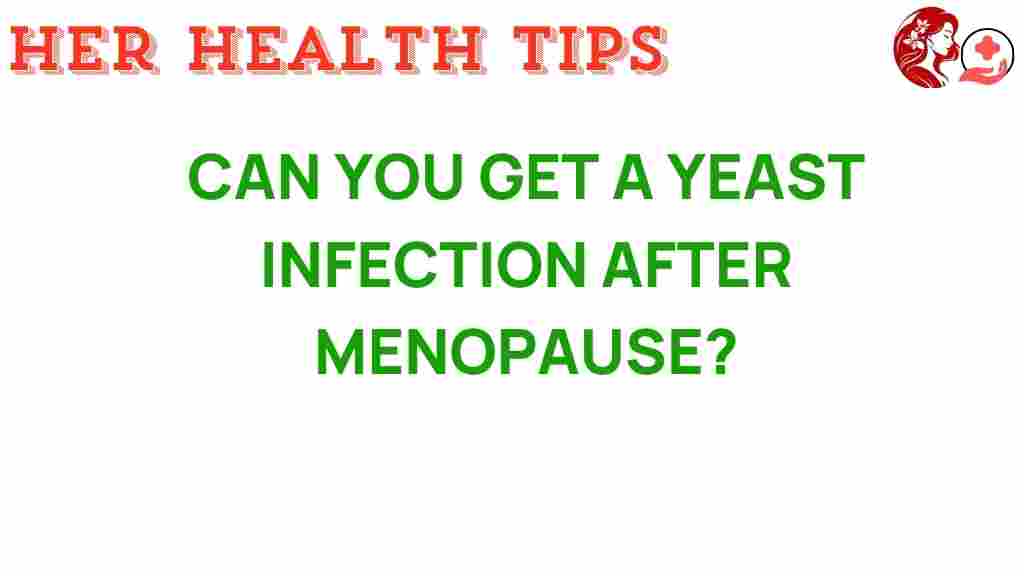Unraveling the Mystery: Can You Get a Yeast Infection After Menopause?
As women transition through different stages of life, their bodies undergo significant changes, particularly during menopause. One common concern that arises is the risk of developing a yeast infection after menopause. This article aims to explore the relationship between yeast infections, menopause, and overall vaginal health, providing insights into symptoms, treatment options, and preventive measures for postmenopausal women.
Understanding Yeast Infections
A yeast infection, also known as candidiasis, is a common fungal infection caused by an overgrowth of the Candida species, particularly Candida albicans. While yeast infections can affect anyone, they are particularly prevalent among women, especially during hormonal changes such as those experienced in menopause.
The Role of Hormones in Vaginal Health
During menopause, a woman’s body experiences a significant drop in estrogen levels. Estrogen plays a crucial role in maintaining vaginal health by:
- Regulating the vaginal flora.
- Maintaining the thickness and elasticity of vaginal tissues.
- Supporting natural lubrication.
As estrogen levels decline, women may experience various symptoms, including vaginal dryness, irritation, and an increased risk of infections, including yeast infections.
Symptoms of Yeast Infections After Menopause
Knowing the symptoms of a yeast infection is crucial for timely diagnosis and treatment. Common symptoms include:
- Itching and irritation: A persistent itch in the vaginal area.
- Redness and swelling: Inflammation of the vulva and vaginal tissues.
- Unusual discharge: A thick, white, odorless discharge resembling cottage cheese.
- Pain during intercourse: Discomfort or pain during sexual activity.
- Burning sensation: A burning feeling during urination.
If you experience these symptoms, it is essential to consult a healthcare provider for proper diagnosis and treatment.
Causes of Yeast Infections in Postmenopausal Women
Several factors can contribute to the development of yeast infections after menopause, including:
- Hormonal changes: Decreased estrogen levels can disrupt the balance of bacteria and yeast in the vagina.
- Vaginal dryness: Reduced lubrication can lead to irritation and inflammation, making the vaginal area more susceptible to infections.
- Antibiotic use: Antibiotics can kill beneficial bacteria, allowing yeast to overgrow.
- Diabetes: Uncontrolled diabetes can lead to elevated sugar levels, which promote yeast growth.
- Weakened immune system: Conditions that compromise the immune system can increase the risk of infections.
Treatment Options for Yeast Infections
When it comes to treating yeast infections, several options are available. Treatment may include:
Over-the-Counter Antifungal Medications
Many postmenopausal women find relief with over-the-counter antifungal creams or suppositories. Common options include:
- Clotrimazole: Available as a cream or vaginal tablet.
- Miconazole: Available in various forms, including cream and suppositories.
- Terconazole: A prescription option for more severe infections.
Prescription Medications
If over-the-counter treatments are ineffective, a healthcare provider may prescribe stronger antifungal medications, such as:
- Fluconazole: An oral medication that treats yeast infections effectively.
- Other antifungal drugs: Depending on the severity and recurrence of infections.
Hormonal Treatments
For postmenopausal women, hormone replacement therapy (HRT) may help alleviate some symptoms associated with vaginal dryness and discomfort, potentially reducing the risk of yeast infections. Discussing the risks and benefits of HRT with a healthcare provider is essential.
Preventing Yeast Infections After Menopause
Preventing yeast infections is crucial for maintaining vaginal health. Here are some effective strategies:
- Maintain proper hygiene: Keep the vaginal area clean and dry. Use mild, unscented soap for cleansing.
- Wear breathable clothing: Opt for cotton underwear and loose-fitting clothes to allow air circulation.
- Avoid irritants: Steer clear of scented products, douches, and harsh soaps that can disrupt the vaginal flora.
- Stay hydrated: Drinking plenty of water can help maintain overall health and hydration.
- Monitor your diet: A balanced diet low in sugar can help reduce the risk of yeast overgrowth.
- Consider probiotics: Probiotic supplements can help restore the natural balance of bacteria in the vagina.
- Consult a healthcare provider: Regular check-ups can help monitor vaginal health and address any concerns.
Troubleshooting Tips for Recurrent Yeast Infections
If you find yourself experiencing recurrent yeast infections after menopause, consider the following troubleshooting tips:
- Keep a symptom diary: Track your symptoms, diet, and any medications to identify potential triggers.
- Review your medications: Discuss with your doctor whether any medications may be contributing to the problem.
- Evaluate your blood sugar levels: If you have diabetes, ensure that it is well-managed to reduce the risk of yeast infections.
- Consider hormone therapy: Discuss with your healthcare provider if HRT might be appropriate for you.
- Practice safe sex: Use protection to reduce the risk of sexually transmitted infections that could exacerbate vaginal issues.
Conclusion
In conclusion, while yeast infections can occur after menopause, understanding the underlying causes, symptoms, and treatment options is essential for maintaining women’s health and vaginal health. By taking proactive steps to prevent yeast infections and consulting healthcare providers for persistent issues, postmenopausal women can enjoy a more comfortable and healthy life.
For more information on women’s health topics, consider visiting WomensHealth.gov for reliable resources and support.
If you’re looking for additional insights on managing postmenopausal symptoms, check out our comprehensive guide to postmenopausal care.
This article is in the category Reproductive and created by HerHealthTips Team
